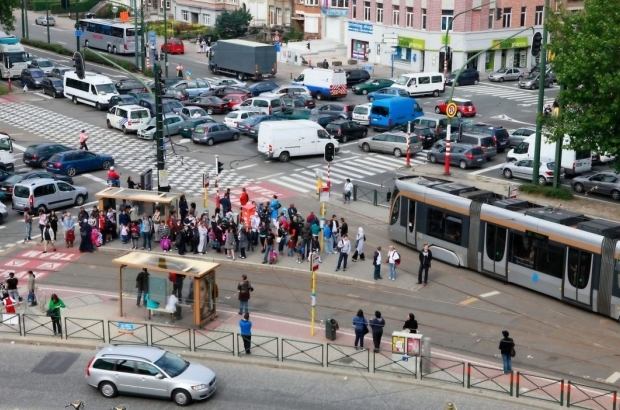- Daily & Weekly newsletters
- Buy & download The Bulletin
- Comment on our articles
Brussels' notorious Place Meiser to receive complete overhaul
Place Meiser, one of Brussels' most dangerous and congested junctions, will be completely overhauled to improve public safety.
The area will see the introduction of semi-pedestrian zones, greenery, safer junctions and a rerouted tram, RTBF reports.
The thorough reconstruction will mean that the roundabout will no longer be a roundabout, according to the project’s details.
The enormous square in Schaerbeek has been nicknamed Place Misère, given its reputation for being unsafe and seemingly permanent car traffic.
An application for planning permission will be submitted before this summer, Brussels mobility minister Elke Van den Brandt (Groen) confirmed, with construction expected to begin in a year and a half.
“Meiser is an old-fashioned, dangerous, inefficient square that is not liveable for the inhabitants,” Van den Brandt said.
“We want to change this, to achieve a smoother flow of traffic, a more legible square, less dangerous, better protected, more pleasant for the residents.”
Schaerbeek has been making repeated requests to the Brussels region for a complete overhaul of Place Meiser for more than two decades. The area is classified as a ‘Zaca’, or ‘accident-prone area’.
The space, originally called Place Ernest Cambier, was created in 1912 and has not changed since its transformation into a roundabout in 1952, apart from its name change in 1928 in honour of former mayor Jean-Baptiste Meiser.
The works now planned include the removal of the roundabout to create two separate junctions: first with the Boulevard Wahis-Reyers axis, then with the Avenue Cambier-Rogier-Plasky axis.
At Meiser, cars coming from Schaerbeek via the Chaussée de Louvain will have five traffic lanes: two to go left towards Wahis, two to go right towards Reyers and one to continue towards Evere.
In the other direction, motorists coming from Evere will have three lanes: one to join Avenue Rogier (which will no longer be connected to Avenue Ernest Cambier), a central lane to continue on the Chaussée de Louvain and the last one to go to Avenue Plasky.
In both directions, safe cycle paths will be added so that cyclists no longer have to share their lane with Stib buses.
“This new configuration of the crossroads allows a significant gain for active modes of transport and a more qualitative space at the entrance to the city,” say project developers Brussels Mobility, Stratec, Espaces Mobilités and Transitec.
The removal of the roundabout will make it possible to gain around 6,500m² of surface area - 3,500² on the Wahis-Cambier-Rogier side and around 3,000² on the Plasky-Reyers side.
“This gain offers the possibility of integrating large spaces for walking and qualitative green spaces to reduce the heat island effect,” the developers said.
Both the open area on the Cambier side and the area on the Plasky side will be levelled and decorated with trees and other greenery, transforming the spaces into two semi-pedestrian areas with possible connections in local traffic between Plasky and Reyers and between Wahis and Cambier.
“We want more accessible public spaces,” minister Elke Van den Brandt said. “We want to greenify this place, plant a number of trees – turn this place into a real square instead of a roundabout.”
The last element of the plan is public transport. Tram 25 coming from Reyers will no longer enter Avenue Rogier by crossing Meiser diagonally but by running along the future Cambier square. Buses will have their own lane on the Chaussée de Lovain, but once on Meiser they will share the lanes with cars.
The actors behind the project do not believe the overhaul will clash with other major redevelopment projects in the area – even considering the underground tram.
“This Mediatram project is a long-term project that will make it possible to provide a more efficient service to the middle ring road,” Van den Brandt explained.
“The idea is therefore to go underground, under the Place Meiser. We are starting with the square first because we cannot wait until later to dig a tunnel for the tram. The two projects are completely compatible and will be phased.”
The municipality of Schaerbeek was involved in project discussions, even though the road network is regional and the final say rests with the Brussels region.
But while many consider the new version an improvement, critics are not completely satisfied.
“Finally, after so many years, they are taking an interest in the mobility of the Place Meiser, which is a major road safety issue with regular fender-benders and sometimes even much more serious accidents,” said acting mayor Cécile Jodogne (DéFI).
“It is a complex area – that's why few people have dared to tackle it. We are delighted that the region is now making proposals, [but] it's quite regrettable that it's a mess.”
Jodogne said that the Reyers boulevard “has only been provisionally developed – it’s true that it has obtained a planning certificate, but it is not yet a permit”.
The mayor also added that “as far as Boulevard Lambermont is concerned, the project will only be subject to an application for planning permission from the region.
"All of this is now being done, together with Place Meiser, without us being able to get an overview. Obviously, there are questions in terms of traffic transfers. We regret the lack of an overall vision of these three or four major projects in this district.”
Jodogne said the municipality had already set up a mobility plan between Avenue Cambier and Avenue des Azalées with one-way streets, which will have an impact on mobility up to Place Meiser after renovation.
“We have in any case forwarded our questions to the region and we hope to receive answers before the permit application is submitted,” said Jodogne. “A focus on road safety is essential for us.”



















Comments
Any time frame mentioned? Months, years, decade(s)?